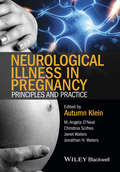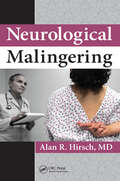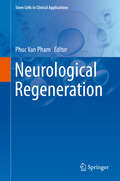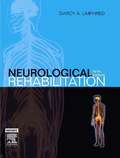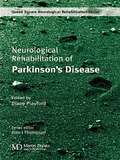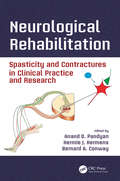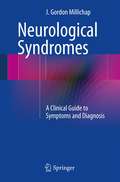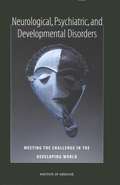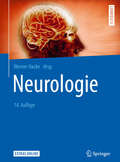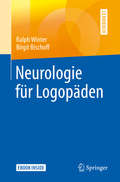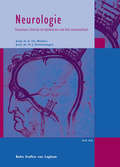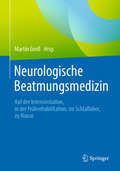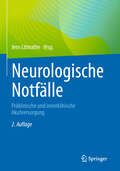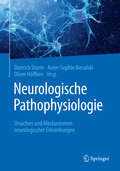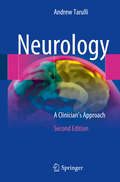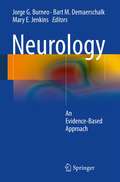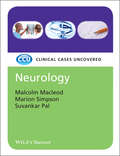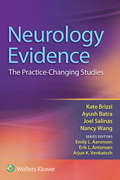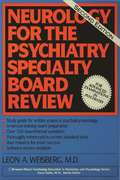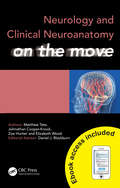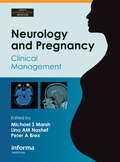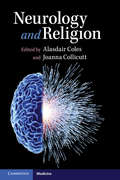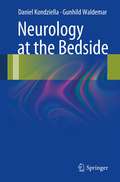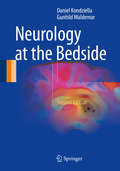- Table View
- List View
Neurological Illness in Pregnancy
by Autumn Klein Janet Waters Christina Scifres Jonathan H. Waters M. Angela O'NealThis book is a practical and easily readable guide for neurologists, obstetricians, and primary care doctors treating female patients with neurological illness in their reproductive years. Offers wide ranging coverage, including family planning and lactation Presents information in approachable tables and summaries, focusing on high yield information useful for clinical consultation Is written by a team of experts and edited by recognized leaders in the field
Neurological Malingering
by Alan R. HirschWritten from the viewpoint of the practicing clinician, this text is an indispensable addition to the library of anyone who is in the practice of medicine, osteopathy, or chiropractic, as well as for the judge, lawyer, or social worker who may interact with those presenting with the possibility of malingering. Other topics discussed include Waddell’s Signs, the Pinocchio Phenomenon, the Othello Error, the Menace Reflex, the Reliable Digit Span, Lombard’s Test, the Babinski Sign of the Eyebrow, the Hummel Double Conversation Test, the Swinging Story Test, the Judd-Persaud Test, the Teal Test, the Chimani-Moos Test, the Occlusion Effect, the Drop Arm Test, the Drop Leg Test, the Honest Palm Sign, the Elbow-Flex-Ex Sign, Beevor's Sign, Schober's Test, the Babinski Trunk-Thigh Test, and the Barré Test. Advance praise for Neurological Malingering "Dr. Hirsch’s book is long overdue and covers a critical topic of concern to all medical practitioners. This comprehensive treatise is a must for all physicians, psychologists, and others who work with patients who have incentive to gain from the system. Multiple topics related to malingering are presented in 16 straightforward chapters never before compiled in a single volume. I recommend this book highly to anyone concerned about malingering and its impact on the medical system." - Richard L. Doty, PhD, FAAN, Professor and Director, Smell and Taste Center, Perelman School of Medicine, University of Pennsylvania "Malingering affects not only the malingerers, but the persons and institutions around them as well. As a lay person, the readings have certainly made me considerably more sensitive to suspect behavior. And where knowledge of the underlying condition can affect relationships or transactions one is associated with, it is certainly useful to not only recognize its existence, but also to put it within the context of the challenges that it presents to those relationships or transactions. I count the time spent reading this most comprehensive work as well spent. I would further recommend it to others whose interests, decisions and/or professional pursuits could very well be affected by malingering, whether the behavior is or is not purposeful." - Judge Stephen A. Schiller (Retired), Circuit Court of Cook County, Illinois
Neurological Regeneration
by Phuc Van PhamThis invaluable resource discusses clinical applications with effects and side-effects of applications of stem cells in neurological regeneration. Each chapter is contributed by a pre-eminent scientist in the field and covers stem cell applications and cell-based therapies for spinal cord injury and regeneration, traumatic brain injury, glioblastoma, Parkinson's Disease, ischemic stroke and more. Future directions of these therapies are also discussed. Neurological Regeneration and the other books in the Stem Cells in Clinical Applications series will be invaluable to scientists, researchers, advanced students and clinicians working in stem cells, regenerative medicine or tissue engineering.
Neurological Rehabilitation
by Darcy Umphred Gordon U. Burton Rolando T. Lazaro Margaret L. Roller.Explores various rehabilitation options for people with a neurological disorder in terms of latest screening and diagnostics, advances in treatment and interventions used in modern clinical practice.
Neurological Rehabilitation of Parkinson's Disease
by Diane PlayfordThe rehabilitation of Parkinson's disease patients comprises various forms of therapy: physical, speech and psychosocial therapy. Physical rehabilitation is used in conjunction with various anti-parkinsonian agents as a non-pharmacological treatment for Parkinson's disease. This book explores the long-term and short-term benefits of physical therap
Neurological Rehabilitation: Spasticity and Contractures in Clinical Practice and Research (Rehabilitation Science in Practice Series)
by Anand D. Pandyan Hermie J. Hermens Bernard A. ConwayThis book is the first attempt at bringing together a volume of work from a range of professionals with an interest in spasticity. The framework for the definition was developed in part by the authors contributing chapters that make up this volume. The book represents the current "state-of-the-art" regarding definition, measurement, pathophysiology (all state-of-the-art summaries) and simultaneously gives clinicians guidance on clinical management. This work combines coverage of both spasticity and contractures as these two phenomena are often closely interrelated. Current researchers do not differentiate between these individual impairments and, as such, there is significant confusion in the literature. This book discusses both conditions and then separates them into their respective components. If these two conditions co-exist (which is generally the case), then the management of a patient will need to be customized to individual clinical presentation. The clinical sections of the book are all written by currently practicing, and research active, clinicians, and the earlier chapters are written by researchers currently working on spasticity. In summary, this book: <li>Provides information that is clinically relevant and strongly researched <li>Includes clinical studies covering both spasticity and contractures, which is unique <li>Presents editors and contributors that are world-class experts <li>Takes a cookbook approach to measurements in clinical studies and research <li>Contains extensive references that are included at the end of each chapter
Neurological Syndromes: A Clinical Guide to Symptoms and Diagnosis
by J. Gordon MillichapNeurological Syndromes: A Clinical Guide to Symptoms and Diagnosis offers a concise, invaluable resource for understanding how a group of neurologic symptoms or signs collectively characterize a disease or disorder. Intended as a quick reference guide to the better known and some less familiar syndromes of neurological interest and developed by a renowned pediatric neurologist with more than 40 years experience in treating children, adolescents, and young adults, this handy title provides a definition of each syndrome that includes diagnostic characteristics and abnormalities, a differential diagnosis, genetic considerations, and a short list of references. To those readers who can recall the name of a syndrome, the alphabetical presentation should facilitate a review of the major diagnostic characteristics. The original reference is provided for historical interest, and review articles are included to show recent advances in etiology and treatment. The index is arranged in alphabetical order of the named syndromes and also according to the involvement of various organs in addition to the nervous system. A unique contribution to the literature, Neurological Syndromes: A Clinical Guide to Symptoms and Diagnosis will be of great interest to the wide variety of clinicians treating patients with neurologic disease.
Neurological, Psychiatric, and Developmental Disorders: Meeting the Challenge in the Developing World
by Institute of MedicineBrain disorders—neurological, psychiatric, and developmental—now affect at least 250 million people in the developing world, and this number is expected to rise as life expectancy increases. Yet public and private health systems in developing countries have paid relatively little attention to brain disorders. The negative attitudes, prejudice, and stigma that often surround many of these disorders have contributed to this neglect. Lacking proper diagnosis and treatment, millions of individual lives are lost to disability and death. Such conditions exact both personal and economic costs on families, communities, and nations. The report describes the causes and risk factors associated with brain disorders. It focuses on six representative brain disorders that are prevalent in developing countries: developmental disabilities, epilepsy, schizophrenia, bipolar disorder, depression, and stroke. The report makes detailed recommendations of ways to reduce the toll exacted by these six disorders. In broader strokes, the report also proposes six major strategies toward reducing the overall burden of brain disorders in the developing world.
Neurologie (Springer-Lehrbuch)
by Werner HackeIm Studium die Nerven behaltenDieses bewährte Lehrbuch vermittelt Ihnen das gesamte Neurologie-Prüfungswissen für Ihr Medizinstudium und bereitet auch junge Assistenzärzte durch detailliertes Fachwissen optimal auf die Praxis vor. Das neue farbige Layout und der homogene Schreibstil unterstützen dabei Ihren Lernerfolg.Der InhaltDiese komplett überarbeitete Auflage enthält 6 neue, interdisziplinäre Kapitel:Neurologische Intensivmedizin – Neuroimmunologische Therapieprinzipien – Neurogenetik – Neurogeriatrie – Neurologische Rehabilitation – Neurologische PalliativmedizinDas ausgefeilte didaktische Konzept hilft Ihnen das Wichtigste zu verinnerlichen− Merksätze zeigen Ihnen das Wesentliche auf− Facharztboxen bieten Ihnen vertieftes Spezialwissen− Fälle schärfen Ihren Blick für die KlinikDer HerausgeberProf. Dr. Dr. h.c. Dipl.-Psych. Werner Hacke war von 1987 bis 2014 Direktor der Neurologischen Universitätsklinik Heidelberg. Er war Präsident der Deutschen Gesellschaft für Neurologie, der Deutschen Schlaganfallgesellschaft, der Deutschen Gesellschaft für Neurointensivmedizin, Gründungs- und Ehrenpräsident der Europäischen Schlaganfallorganisation. Prof. Hacke war und ist Autor und Herausgeber mehrerer Bücher und vieler wissenschaftlicher Zeitschriften, unter anderem von Stroke, Neurology, Int. J Stroke und Der Nervenarzt. Er ist einer der meistzitierten Neurologen weltweit.
Neurologie für Logopäden
by Ralph Winter Birgit BischoffAphasie, Dysphagie, Dysarthrie - Viele von Logopäden behandelte Störungen beruhen auf neurologischen Erkrankungen. Deren klinische Ausprägungen, Begleitsymptome und Komplikationen zu kennen, ist Voraussetzung für eine erfolgversprechende logopädische Therapie. Mit diesem Lehrbuch lernen Sie, die Symptome neurologischer Krankheiten zu unterscheiden und Ungewöhnliches zu erkennen. Erfahren Sie außerdem, wie Sie in Notfällen rasch und richtig handeln, und informieren Sie sich zum Umgang mit krankheitsbedingten Störungen wie z.B. Aufmerksamkeitsdefiziten, die die logopädische Arbeit erschweren. Für Schüler und Studierende der Logopädie und für praktisch tätige Logopäden.
Neurologie: Structuur, functie en dysfunctie van het zenuwstelsel (Quintessens)
by E. Ch. Wolters H. J. GroenewegenDe chroniciteit van veel neurologische aandoeningen vraagt van de huisarts veel zorg. Niet altijd staan de acute ziekteverschijnselen op de voorgrond, waardoor een neurologische aandoening een complexe ziekte is. In dit boek worden veel verschillende neurologische onderwerpen besproken, variërend van lage rugpijn en duizeligheid tot myasthenia gravis en het syndroom van Guillain-Barré. Neurologie is het negende deel in de reeks Praktische huisartsgeneeskunde. In deze reeks verschijnen uitgaven met praktische en klachtgerichte informatie over de verschillende deelgebieden in de huisartsgeneeskunde. Het boek is totstandgekomen door een nauwe samenwerking tussen huisartsen en neurologen.
Neurologische Beatmungsmedizin: Auf der Intensivstation, in der Frührehabilitation, im Schlaflabor, zu Hause
by Martin GroßDas vorliegende Buch präsentiert das gesamte klinische und wissenschaftliche Spektrum der neurologischen Beatmungsmedizin. Es wendet sich an alle Ärzte, die beatmete neurologische Patienten betreuen, wie Neurologen, Anästhesisten, Internisten, Pneumologen, Intensivmediziner, Schlafmediziner und Palliativmediziner. Das Werk vermittelt sowohl die für die neurointensivmedizinische und neurorehabilitative Behandlung als auch die für die optimale Versorgung außerklinisch beatmeter Patienten erforderlichen Kenntnisse. Zahlreiche Handlungsempfehlungen für das Vorgehen bei den oft schwierigen Beatmungs- und Atemwegssituationen machen das Werk besonders praxistauglich.
Neurologische Notfälle: Präklinische und innerklinische Akutversorgung
by Jens LitmatheDas Werk beschreibt die Akutdiagnostik und Akuttherapie der wichtigsten neurologischen Notfallsituationen, wie ischämischer Schlaganfall, intrakranielle Blutungen, Krampfanfälle, Meningitis, Enzephalitis, Bewusstseinsstörungen, Schwindel und Kopfschmerzen. Gegliedert in präklinische und innerklinische Akutversorgung ist es ein idealer Begleiter sowohl für präklinisch tätige Notärztinnen und Notärzte als auch für diejenigen, die innerklinisch neurologische Notfälle versorgen, z.B. in zentralen oder interdisziplinären Notaufnahmen. Auch auf häufig vorkommende neurologische Notfälle bei Kindern geht das Werk ein, ebenso wie auf psychiatrische Notfälle sowie Bildgebung und Interventionen im Notfall. Die 2. Auflage wurde vollständig aktualisiert und erweitert. Die Gliederung orientiert sich zunächst nach den wichtigsten Leitsymptomen und geht dann auf spezifische notfallmedizinisch relevante Krankheitsbilder ein. Zahlreiche Tipps und ein Frage-Quiz zur Selbstkontrolle machendas Buch besonders praxisnah.
Neurologische Pathophysiologie: Ursachen und Mechanismen neurologischer Erkrankungen
by Dietrich Sturm Anne-Sophie Biesalski Oliver HöffkenEin Lehrbuch für Ärzte in Weiterbildung für das Fach Neurologie, das die pathophysiologischen und die biochemischen Ursachen und Komplikationen neurologischer Erkrankungen verständlich darstellt und sinnvoll in den klinischen Gesamtzusammenhang einordnet. Im Medizinstudium wird die genaue Kenntnis der Neuroanatomie als Grundlage für klinisch-neurologische Diagnostik und Therapie gelehrt. In der klinischen Praxis ist es jedoch relevant, neben dem neurologisch-topischen Wissen auch die pathophysiologischen Grundlagen zu begreifen, um daraus adäquate therapeutische Schritte ableiten zu können. Die Fülle theoretischer Grundlagen erschwert es sowohl Berufsanfängern als auch Studierenden, den Überblick zu behalten. Genau diese Lücke füllt das vorliegende Buch.
Neurology
by Andrew TarulliThis review text goes over the key concepts and topics of neurology, for medical students and residents in rotations or studying for the USMLE. Drislane (neurology, Harvard Medical School) et al. cover basic principles, common neurological symptoms like dizziness, ataxia, and headache, and diagnosis and treatment of neurologic disorders from dementia and seizures to movement disorders and pediatric problems. This edition has been updated to include new diagnostic and treatment information. It is meant to be a study aid for students written by students, so includes contributors who are residents. USMLE-style questions and answers are provided. Annotation ©2009 Book News, Inc. , Portland, OR (booknews. com)
Neurology
by Andrew TarulliThis concise, thoroughly updated text provides a comprehensive, state-of-the art review of neurology and will serve as a highly practical resource for neurology residents and medical students. Emphasizing a practical approach to common neurologic disorders, the author blends chapters that cover the evaluation of specific complaints (confusion, dizziness and vertigo, visual loss, headache and facial pain) with others that focus on particular disorders (Parkinsonism, multiple sclerosis, dementia). Noting the core practice of neurology is largely unchanged from years ago and still largely done at the bedside, the author emphasizes the importance of acquiring expertise in the time-tested, classical techniques of history taking, directed examination, and localization. Toward that, the author encourages a focus on the key clinical pathways for diagnosis and management. A wide range of clinical pearls are provided and the diagrams and illustrations are well-designed and comprehensible, as are the clinical images (EEGs, CT, MRI) which provide excellent examples of a variety of neurologic disorders. The discussions and algorithms offered are evidence-based and state-of-the-art. Importantly, the author discusses a range of new, powerful treatments available for various disorders, including stroke, epilepsy, and multiple sclerosis. Concise and well-written, Neurology: A Clinician's Approach, 2nd Edition is an invaluable resource that will again serve as a very useful, gold-standard resource for trainees.
Neurology
by Bart M. Demaerschalk Mary E. Jenkins Jorge G BurneoEvidence-based Clinical Practice (EBCP) is the conscientious, explicit, and judicious use of current best external evidence in making decisions about the care of individual patients. In neurology, practice has shifted from a rich, descriptive discipline to one of increasingly diagnostic and therapeutic interventions. Providing a comprehensive review of the current best evidence, Neurology: An Evidence-Based Approach presents this type of evidence in a concise, user-friendly and easily accessible manner. The three co-editors of this important volume are linked in their passion for evidence-based clinical practice in the clinical neurological sciences, connected to a common historical origin at the University of Western Ontario (UWO), London, Ontario Canada and influenced directly by Evidence-Based Medicine teachings of McMaster University, Hamilton, Ontario Cananda. The book is organized in three sections: Basics of Evidence-Based Clinical Practice, with an introduction to the topic, a chapter on the evolution of the hierarchy of evidence, and another chapter on guidelines for rating the quality of evidence and grading the strength of recommendation. The second section, Neurological Diseases, provides an illuminating overview of evidence-based care in ten of the most common areas in neurologic practice. The final, third section provides an outstanding roadmap for teaching evidence-based neurology with a chapter on the Evidence-Based Curriculum. A superb contribution to the literature, Neurology: An Evidence-Based Approach offers a well designed, well written, practical reference for all providers and researchers interested in the evidence-based practice of neurology.
Neurology Clinical Cases Uncovered
by Malcolm Macleod Marion Simpson Suvankar PalNeurology is a rapidly advancing core topic within the clinical curriculum and students and junior doctors are expected to recognise, understand and know how to investigate and manage many neurological-related disorders and conditions. Neurology: Clinical Cases Uncovered leads students through the clinical approach to managing neurological problems via real-life patient cases and outcomes. Following a question-answer approach to developing the narrative, and including self-assessment MCQs, EMQs and SAQs, the book includes 27 fully-illustrated cases covering a wide range of neurological presentations and conditions. Ideal for medical students with clinical attachments in neurology, and in the run up to examinations, the book will also be useful to doctors in training in general internal medicine, medicine of the elderly, psychiatry and neurology.
Neurology Evidence: The Practice Changing Studies
by Joel Salinas Kate T. Brizzi Ayusha Batra Nancy WangSynthesizing the vast body of literature available in neurology into one accessible, clinically relevant volume, Neurology Evidence: The Practice-Changing Studies is an invaluable resource for students, residents, and fellows, as well as neurologists at all levels of experience. Featuring the top 100 papers that have had the most significant impact on changing clinical practice, this unique title analyzes the strengths and weaknesses of both seminal and less-noticed studies. Readable commentary is provided for each study by both a senior and junior neurologist in each subspecialty.
Neurology For The Psychiatry Specialist Board
by Leon A. WeisbergThis new edition of Neurology for the Psychiatry Specialty Board Review, provides an accurate and comprehensive review of the most frequently encountered topics in the field of clinical neurology and neuroscience.The second edition features all new questions and provides answers and explanations that are referenced to standard textbooks. It offers a varied testing format, including clinical vignettes and matching, true-false, and multiple choice questions. The author consulted with medical students and faculty on incorporating new material. Neurology for the Psychiatry Specialty Board Review, Second Edition is a thorough and indispensable tool for preparing for the board certification or re-certification examination in psychiatry or neurology, for in-service training examinations, or simply as a test of the reader's knowledge of the field.
Neurology and Clinical Neuroanatomy on the Move (Medicine on the Move)
by Matthew Tate Johnathan Cooper-Knock Zoe Hunter Elizabeth WoodThe Medicine on the Move series provides fully flexible access to subjects across the curriculum in a unique combination of print and mobile formats ideal for the busy medical student and junior doctor. Neurology and Clinical Neuroanatomy on the Move provides sharply focused content equally suited to those studying the subject for the first time or
Neurology and Pregnancy: Clinical Management (Series in Maternal-Fetal Medicine)
by Michael S. Marsh Lina A. M. Nashef Peter A. BrexPregnancy complicated by neurological disorders is a challenging area for both obstetricians and neurologists. Treatment of the maternal condition often needs to be adjusted because of concerns for the fetus, and some conditions have a major impact on the method, mode, and timing of delivery. Many of the clinical problems that arise in pregnant wom
Neurology and Religion
by Alasdair Coles Joanna CollicuttThis innovative book examines what can be learnt about the brain mechanisms underlying religious belief and practice from studying people with neurological disorders, such as stroke, epilepsy and Parkinson's disease. Using a clinical case study approach, the book analyses the interaction of social influences, religious upbringing and neurological disorders on lived religious experience in a number of different religions. The interdisciplinary contributors to the book ensure a variety of perspectives to help understand how the religious life is affected when different cognitive functions are impaired; how faith modifies the effects of neurological disorders; and how awareness of faith practices may assist in the treatment of these conditions.
Neurology at the Bedside
by Daniel Kondziella Gunhild WaldemarThis book teaches readers the clinical skills residents in neurology have to acquire in the course of their training, and approaches neurology like a doctor approaches a patient: first there is a chapter on how to perform an efficient neurological history according to neuroanatomical key features, then a chapter on the bedside examination, followed by chapters on differential diagnosis, diagnostic procedures and lastly, the treatment. Neurology at the Bedside aims to provide readers with a personal clinical mentor. It takes them by the hand and guides them through the whole patient encounter from the history to the treatment, at each step pointing out what is essential and what is not. Extensive differential diagnostic flow charts and detailed treatment suggestions make it a perfect coat pocket reference for the wards. In addition, more than 50 unique case histories cover the entire spectrum of the field. Neurology at the Bedside is written for neurologists in training: residents as well as senior house officers. Also medical students, general practitioners and others with an interest in neurology will find invaluable information here that is difficult to look up in traditional textbooks or online references.
Neurology at the Bedside
by Daniel Kondziella Gunhild WaldemarThis book teaches readers the clinical skills residents in neurology have to acquire in the course of their training, and approaches neurology like a doctor approaches a patient: first there is a chapter on how to perform an efficient neurological history according to neuroanatomical key features, then a chapter on the bedside examination, followed by chapters on differential diagnosis, diagnostic procedures and lastly, the treatment. Neurology at the Bedside aims to provide readers with a personal clinical mentor. It takes them by the hand and guides them through the whole patient encounter from the history to the treatment, at each step pointing out what is essential and what is not. Extensive differential diagnostic flow charts and detailed treatment suggestions make it a perfect coat pocket reference for the wards. In addition, more than 50 unique case histories cover the entire spectrum of the field. Neurology at the Bedside is written for neurologists in training: residents as well as senior house officers. Also medical students, general practitioners and others with an interest in neurology will find invaluable information here that is difficult to look up in traditional textbooks or online references.
